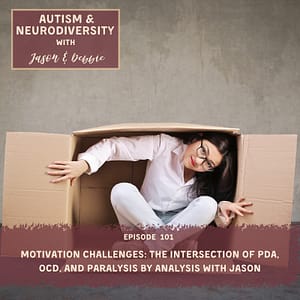[00:03] Jason: Welcome to the Autism and Neurodiversity podcast.
[00:06] Debbie: We’re here to bring you helpful information from leading experts and give you effective tools and support. I’m Jason Grygla, a licensed counselor and founder of Techie for Life, a specialized mentoring program for neurodiverse young adults.
[00:19] Jason: And I’m Debbie Grygla, a certified life coach. And maybe most importantly, we’re also parents to our own atypical Young Adults.
[00:30] Debbie:
Friends. Hello. Welcome. I am so glad you’re here.
If you’re one of our listeners, I know you’re here because you want to support your neurodivergent child, teen or young adult or those that you work with, and you want to see them succeed in what they’re motivated to pursue and to create and do in the world. And motivation is a big challenge.
It’s a big one that I hear parents struggling with. It’s one that I struggled with, and it’s a big one that I hear parents describing when they’re looking at sending their young adults our school, Techie for Life.
And a lot of them, it’s their own like they express. I struggle with motivation. So one of the biggest mistakes that I see struggling parents and mentors make in their effort to motivate is how they’re actually unintentionally demotivating their young person. Jason and I used to make this mistake all the time, and it was so frustrating, and we didn’t even realize what we were doing, and we would blame it on our kids, and we just didn’t understand what was at the root of why they weren’t motivated, or at least they weren’t motivated to do the things that we knew would benefit them.
And we didn’t understand our role in that motivation and how we were actually demotivating them by how we were interacting with them. And when you start to understand what I’m going to be talking about here, you’re going to understand your kiddos so much better. Your relationship and your connection will grow so much stronger, and you’re going to be able to stop showing up in a way that is so demotivating.
So many parents and people working with neurodivergent young people just aren’t aware, and they stay stuck in patterns that are actually sabotaging all of their work and their efforts to help.
So this is super important to get, and you’re going to want to educate everyone on the team who works with your young person or that you’re working with. So we often think to motivate neurodivergent young people that we need to teach them better, or we need to give them more supports, or we need to maybe up the consequences, the rewards and the punishments. Or we think maybe if we just explain things better or lecture them about why it’s so important, maybe they’ll understand it. Or maybe we think it’s boundaries. We need to have better boundaries. Or we’re just looking for and grasping different things, trying to motivate for an old virgin young person.
So here’s the thing. If you do any of those things or really anything and you’re doing it from a lower brain, stressed, mental, emotional, behavioral state, you will likely send them into a stressed and therefore demotivated lower brain state.
It’s so much less about what you’re doing and it’s so much more about how you’re doing it in what state you’re doing it in. So if you teach from stress, from a stress state, they’re going to sense that. They’re going to feel it. And how you show up looks a certain way if you’re trying to support from a stress date, if you’re trying to give consequences or rewards or things like that. From a stress state, if you’re explaining and lecturing, if you’re trying to hold boundaries, even like really healthy boundaries, but you’re doing it from a stressed, triggered, mental, emotional, behavioral state, they’re going to sense that. They’re going to pick up on that even if you think you’re hiding it.
And autistic and neurodivergent, young people have very limited skills and capabilities in dealing with other people’s stressed lower brain states, OK? What often happens is they end up mirroring you or they’re taking your lead, they’re seeing your stress state and their brain subconsciously just goes, danger, something’s gone wrong. We got to be on high alert. OK?
So it’s kind of like that saying, if mom isn’t happy, ain’t nobody happy. It’s that sense of like when the people that you’re around are stressed or upset or frustrated or anxious, worried, then we start to go, uhoh, what do we need to be stressed and worried about? So then what happens is that their internal or even externally motivated goals, hopes, dreams, desires, all get sabotaged by their lower brains. Need to be safe and to survive at all costs.
Okay, so let me give you an example of this. I’m in the process of teaching my daughter how to drive. She’s got her driver’s permit, my 15 year old, and she is in a dance company. So we drive back and forth a lot. We make lots of trips into town and she is getting lots and lots of practice driving.
And every time we get in the car and she gets behind that wheel, it’s already kind of like danger. Like literally danger if something goes wrong here. And so if I go into that and I have it’s, one of my less favorite things to do as a parent is to teach one of my kiddos how to drive and to be in that passenger side seat where I have very little control, all I can do is show up as a good mentor in that situation.
I don’t have the ability to it would be really hard to take over the steering wheel. I can’t hit the brakes, I can’t do stuff. And so if I show up in that and I’m stressed and I’m like looking for danger at every turn and I’m worried and I’m trying to control and all these things, guess what that does to her? And I have done that some. Like, there are those moments where I’m like, oh my gosh, like, we really are going to die if you don’t, like, do this differently. He gets really stressed and panicked, and she gets flooded, and then she can’t think straight. She panics. She doesn’t know what to do. She starts yelling and getting upset to do. And we both get, like, really worked up. And it’s not a great scenario. It’s not a great environment for learning how to be a safe driver. Okay?
So you have to realize that when you’re stressed, and especially in relation to your kiddo, you have your own stresses. But if you’re stressed about your kiddo, you can very unintentionally trigger their threat response and actually demotivate them from doing or working toward the good thing that you’re wanting for them and that they want for themselves.
And we, as parents and mentors, we might try different things. We might experiment with different supports, and we might work with them to help them learn new competencies and learn life skills. And we want to be doing that from a calm and confident and curious and compassionate mental, emotional, behavioral state so that we aren’t adding to their stress and adding to the worry and anxiety of their experience.
Managing their stress response is one of the main struggles and really often a disability that neurodivergents have that ability to manage, that is one of their challenges. So when we look at how do we actually then do this, how do we show up in a way that isn’t triggering that lower brain stress state? It comes down to managing our stress state and practicing that and being in the practice of being aware of what mental, emotional, behavioral state we’re in and then managing that.
When I get in the car with my daughter, I’m thinking about my own stress level. I go in and I’m actually front loading myself, like, okay, I’m going in this. And I know that this is challenging. It’s stressful. How can I stay calm and be present? There’s no immediate danger we can do this, right? Like, how am I thinking about how I can stay in a calm state? And I’m focusing on what does she need from me to be able to drive safely?
And I am having compassion and giving us both grace. When we do get stressed. When we do get stressed, you know, the first order of business is make sure we’re in safety, but then to calm down and relax and work it through and know that we’re going to be okay. Getting upset with myself for getting upset never helps anything.
So I have compassion and grace for us in the whole circumstance of it. And my primary focus is really staying calm and focused on what does she need from me and how can I be here for her in a way that helps her be able to stay calm and stay focused on developing the skills of driving.
So if you’re thinking, okay, yeah, Debbie, but I am calm and confident, and they’re still not motivated or they’re not doing what they should be doing, I want you to go back and listen to Episode 72 where I talk about how to motivate autistic and neurodivergent young people. And I go into more detail about internal and external motivations in the context of how our brains work in our algae, how development happens, and doing it through the best relationship interaction, which is a mentoring relationship.
And also I would be looking at if they feel safe around you. So you might feel home, confident, you’re showing up with curiosity and compassion. I would be looking at, are they feeling safe around you and how are they perceiving you and taking a look at that. And there might be some things there to be aware of in that questioning of that.
Okay, so when you understand the mental emotional states that drive behavior and development or hinder them, and then you practice NDM neurodevelopmental mentoring that we teach, you can support their motivations on a completely different level and really get to the heart of things. So it’s on our email list so that we can support you more and you can really start practicing nerd about mental mentoring and be able to support motivation and development and an overall sense of wellbeing and really have an amazing relationship with the young people that you love.
I hope you have an amazing week and drive safe and take care.
[13:07] Debbie: Thanks for joining us on this episode of Autism and Neurodiversity with Jason and Debbie. If you want to learn more about our work, come visit us at jasondebbie.com.




